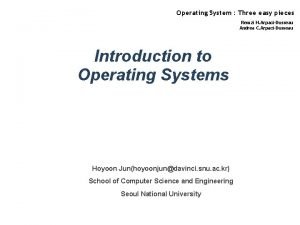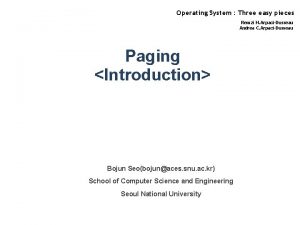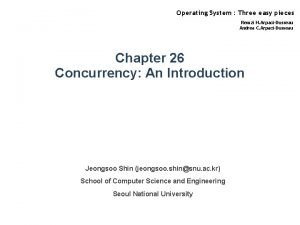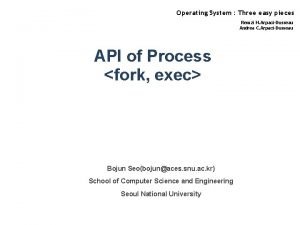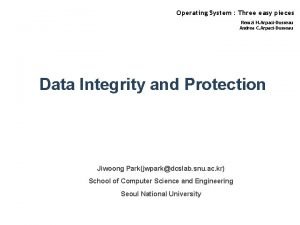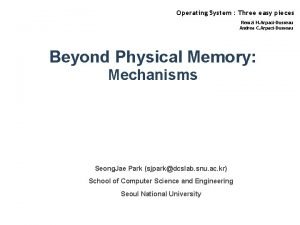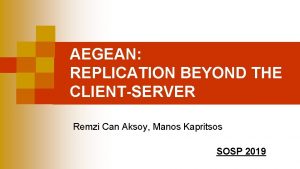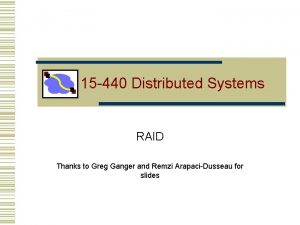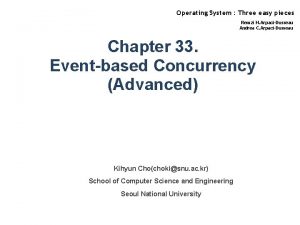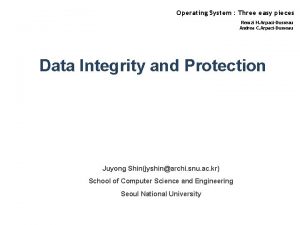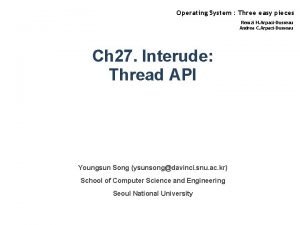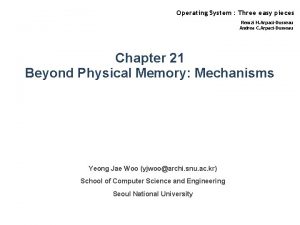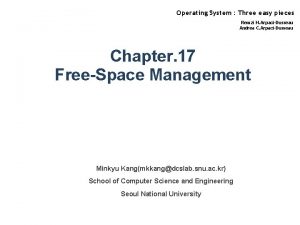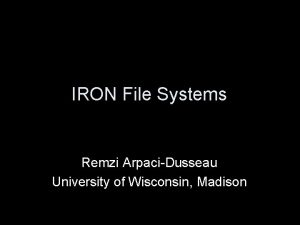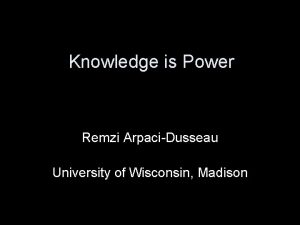Operating System Three easy pieces Remzi H ArpaciDusseau














- Slides: 14

Operating System : Three easy pieces Remzi H. Arpaci-Dusseau Andrea C. Arpaci-Dusseau Paging <Introduction> Bojun Seo(bojun@aces. snu. ac. kr) School of Computer Science and Engineering Seoul National University

Contents § Basic concepts of paging § Paging and virtual addressing § Concepts of page table § Role of page table § Organization of PTE(Page table Entry) § Pitfalls of page table § Too big § Too slow § Observation of its working Operating System : Three easy pieces 2

Basic concepts of paging § OS cannot manage memory spaces without splitting § There are two ways to split the spaces(virtual or physical whatever) § Divide the memory space into variable-sized pieces § Divide the memory space into fixed-sized pieces § The latter(fixed-sized) one is paging variable-sized Operating System : Three easy pieces fixed-sized 3

Paging and virtual addressing § Paging divides each spaces(virtual and physical) into same size § One example how virtual address space is mapped on physical address space A’s Virtual Memory Physical Memory page 0 Physical page frame 0 reserved for OS page 1 Physical page frame 1 A’s page 3 page 2 Physical page frame 2 (unused) page 3 Physical page frame 3 A’s page 1 Physical page frame 4 A’s page 2 Physical page frame 5 (unused) Physical page frame 6 (unused) Physical page frame 7 A’s page 0 Operating System : Three easy pieces 4

Concepts of page table § The mapping information that which goes where should be saved § Page table saves that information § Page table entry can be accessed by VPN(Virtual Page Number) § Each entry keeps PFN(Physical Frame Number) § (and some bit information, which will be dealt on later slides) Operating System : Three easy pieces 5

Role of page table § Example, assume page size of previous picture was 16 bytes § Then, Virtual memory space size is 16*4 = 64 bytes • log 264 = 6 bits § And Physical memory space size is 16*8 = 128 bytes • log 2128 = 7 bits VPN Virtual Va 5 Offset Va 4 Va 3 Va 2 PFN Physical Pa 6 Pa 5 Va 1 Va 0 Pa 1 Pa 0 Offset Pa 4 Operating System : Three easy pieces Pa 3 Pa 2 6

Role of page table § Example, assume page size of previous picture was 16 bytes § Offset bits of physical and virtual memory are exactly same • Translation is not needed • Page table entry doesn’t keep every bits of address VPN Virtual Va 5 Offset Va 4 Va 3 Va 2 PFN Physical Pa 6 Pa 5 Va 1 Va 0 Pa 1 Pa 0 Offset Pa 4 Operating System : Three easy pieces Pa 3 Pa 2 7

Role of page table § Example, assume page size of previous picture was 16 bytes § Translation example VPN Virtual 0 Offset 1 0 1 PFN Physical 0 1 0 1 Offset 1 Operating System : Three easy pieces 0 1 8

Organization of PTE § PTE(Page Table Entry) have PFN and some bits for managing § valid bit: whether translation of this page is valid or not § protection bits: whether this page can be read from, written to, or executed from § present bit: whether this page is on the memory or disk § dirty bit: whether this page has been modified since it was brought into memory § reference bit: used to track whether this page has been accessed, which is useful in determining which pages are popular Operating System : Three easy pieces 9

Organization of PTE § PTE of x 86 architecture source: https: //www. cs. uaf. edu/2007/fall/cs 301/lecture/11_30_cache. html retrieved 2015. 03 Operating System : Three easy pieces 10

Pitfalls of paging(Too big) § Calculate the size of page table § Imagine 32 -bit address space with 4 KB pages § assume 4 bytes per PTE § 220 * 4 = 4 MB § 4 MB memory is needed per process § Imagine we have 100 processes, 400 MB of main memory will be occupied by the page tables § Since maximum memory size of 32 -bit system is 4 GB, 400 MB is too big and cannot be acceptable § In case of 64 -bit system with 4 KB pages § assume 4 bytes per PTE § 252 * 4 = 4 PB(peta bytes) memory is needed per process Operating System : Three easy pieces 11

Pitfalls of paging(Too slow) § Followings are translation steps § extract VPN from virtual address § calculate PTE address § extract PFN(memory accessing) § concatenate PFN and offset § Translation from virtual address to physical address occurs at every instruction § And translation itself is memory referencing, it’s too slow Operating System : Three easy pieces 12

Observation of its working § Page table referencing has temporal and spatial locality C code Operating System : Three easy pieces x 86 assembly 13

Summary § Paging is managing memory with splitting memory with fixed-sized pieces § Translating information from virtual address to physical address is saved in page tables § Each process has its own page table § Naive paging has two problems § Too big page tables § Too slow access speed § Page table referencing has temporal and spatial locality § Maybe. . this property is used to solve the problems above Operating System : Three easy pieces 14
 Operating systems 3 easy pieces
Operating systems 3 easy pieces Operating system three easy pieces
Operating system three easy pieces Operating systems three easy pieces solution
Operating systems three easy pieces solution Inductive vs deductive geometry
Inductive vs deductive geometry Deductive method
Deductive method Example of deductive reasoning
Example of deductive reasoning Remzi h arpaci-dusseau
Remzi h arpaci-dusseau Remzi kulen youtube
Remzi kulen youtube Remzi h. arpaci-dusseau
Remzi h. arpaci-dusseau Remzi h. arpaci-dusseau
Remzi h. arpaci-dusseau Remzi guvenc kulen
Remzi guvenc kulen Remzi can aksoy
Remzi can aksoy Greg remzi
Greg remzi What are the 3 main parts of an essay?
What are the 3 main parts of an essay? Buddy system operating system
Buddy system operating system
